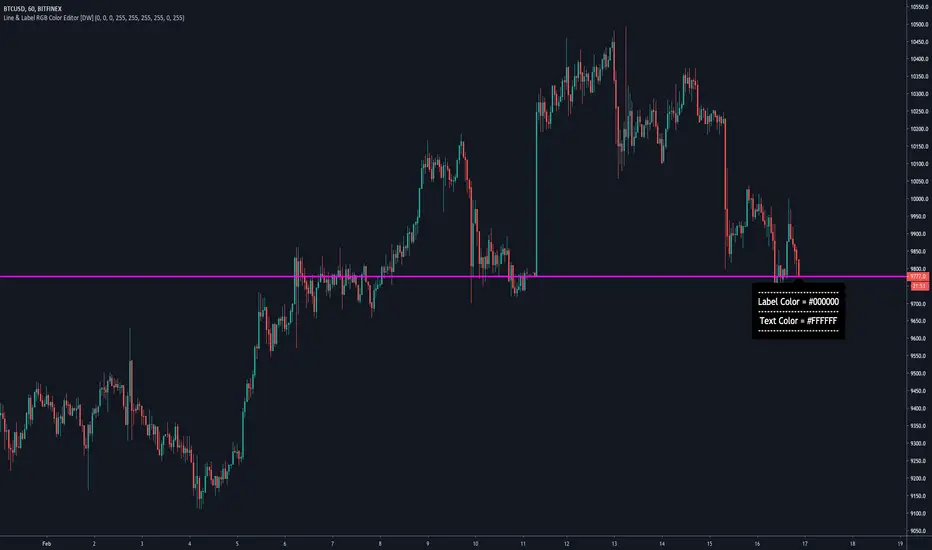OPEN-SOURCE SCRIPT
Actualizado Line & Label RGB Color Editor [DW]

This script is a template designed to provide developers with UI color customization for v4 lines and labels.
The color pallete used within this script is a full spectrum "web safe" format with 216 colors to choose from.
Colors are easily modified via the RGB inputs. The designated color selector function takes in the RGB values and returns the corresponding hex color.
Transparency can be modified as well. However, the color.new function only supports constant integers for transparency value, so it has to be manually adjusted within the code.
On line 42, you'll see a variable within the color selector function named trans. This is the transparency value, which can be set to any integer from 0 to 100. I have it set to 0 by default.
I included a sample label to demonstrate how the color editor works. It also displays the hex codes for the current label and text colors for some additional reference.
Implementing this in your own script is pretty straightforward.
All you need to do is copy the color selector function and inputs (feel free to name them whatever you want) into your desired script. Then, you can use them to declare your color variables.
The color pallete used within this script is a full spectrum "web safe" format with 216 colors to choose from.
Colors are easily modified via the RGB inputs. The designated color selector function takes in the RGB values and returns the corresponding hex color.
Transparency can be modified as well. However, the color.new function only supports constant integers for transparency value, so it has to be manually adjusted within the code.
On line 42, you'll see a variable within the color selector function named trans. This is the transparency value, which can be set to any integer from 0 to 100. I have it set to 0 by default.
I included a sample label to demonstrate how the color editor works. It also displays the hex codes for the current label and text colors for some additional reference.
Implementing this in your own script is pretty straightforward.
All you need to do is copy the color selector function and inputs (feel free to name them whatever you want) into your desired script. Then, you can use them to declare your color variables.
Notas de prensa
Updates:-> Added a sample line for additional demonstration.
-> Reorganized script structure.
Script de código abierto
Fiel al espíritu de TradingView, el creador de este script lo ha convertido en código abierto, para que los traders puedan revisar y verificar su funcionalidad. ¡Enhorabuena al autor! Aunque puede utilizarlo de forma gratuita, recuerde que la republicación del código está sujeta a nuestras Normas internas.
For my full list of premium tools, check the blog:
wallanalytics.com/
Reach out on Telegram:
t.me/DonovanWall
wallanalytics.com/
Reach out on Telegram:
t.me/DonovanWall
Exención de responsabilidad
La información y las publicaciones no constituyen, ni deben considerarse como asesoramiento o recomendaciones financieras, de inversión, de trading o de otro tipo proporcionadas o respaldadas por TradingView. Más información en Condiciones de uso.
Script de código abierto
Fiel al espíritu de TradingView, el creador de este script lo ha convertido en código abierto, para que los traders puedan revisar y verificar su funcionalidad. ¡Enhorabuena al autor! Aunque puede utilizarlo de forma gratuita, recuerde que la republicación del código está sujeta a nuestras Normas internas.
For my full list of premium tools, check the blog:
wallanalytics.com/
Reach out on Telegram:
t.me/DonovanWall
wallanalytics.com/
Reach out on Telegram:
t.me/DonovanWall
Exención de responsabilidad
La información y las publicaciones no constituyen, ni deben considerarse como asesoramiento o recomendaciones financieras, de inversión, de trading o de otro tipo proporcionadas o respaldadas por TradingView. Más información en Condiciones de uso.